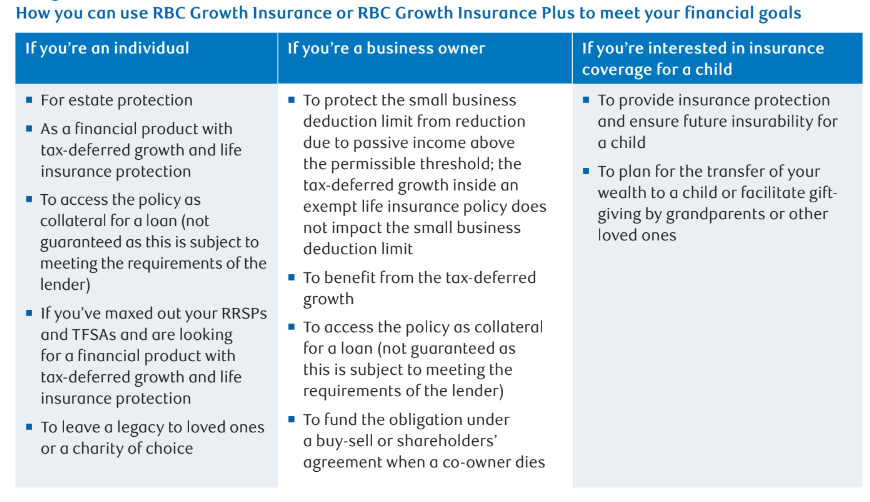- RBC Insurance offers two participating whole life plans with five dividend options: Growth Insurance and Growth Insurance Plus
- Growth Insurance offers lifetime coverage starting at $25,000 and begins accumulating cash value after 5 years. It also includes a juvenile guaranteed insurability benefit for policyholders under 18 at no additional cost
- Growth Insurance Plus offers lifetime coverage starting at $250,000 and begins accumulating cash value after the first year
- What are the benefits of RBC’s whole life insurance?
- What are the different types of RBC whole life insurance?
- How can I access my RBC whole life cash value?
- What happens if I miss a premium payment for my RBC whole life policy?
- Does RBC offer deposit option payments?
- What are the benefits and disadvantages of RBC’s Whole Life Insurance?
- How do you apply for RBC’s whole life insurance?
- Frequently asked questions
Backed by one of Canada’s largest financial institutions, RBC Insurance offers a wide range of products designed to secure your financial legacy. In this review, we’ll explore their whole life insurance offerings, focusing on their key features, benefits, and pros and cons to help you decide if they’re the right fit for your needs.
What are the benefits of RBC’s whole life insurance?
RBC’s whole life insurance offers lifelong coverage with a cash value component you can access during your lifetime. Key benefits include:
- Five dividend options: You can choose to have your annual dividends issued as cash payments, reduced premiums, interest-earning deposits, paid-up additions, or enhanced insurance
- $25,000-$25M coverage: Depending on your needs, you can select coverage amounts ranging from $25,000 to $25 million
- Customizable add-ons: You can get enhanced coverage with optional add-ons like RBC YourTerm 10,15, 20, or 25 life insurance
- Coverage for ages 0-80: You can get coverage for yourself or loved ones at any stage of life
- Flexible payment options: You can choose between lifetime premium payments (Life Pay), or limited payment terms of 10 or 20 years (10 Pay, 20 Pay)
They also have three coverage options:
- Single-life: Insures one person and pays a tax-free death benefit upon their passing
- Joint-first-to-die: Insures two people and pays a tax-free death benefit when the first insured person dies
- Joint-last-to-die: Also insures two people but pays a death benefit when the second insured person dies
What are the different types of RBC whole life insurance?
RBC offers two participating whole life plans with lifetime coverage and cash value accumulation: RBC Growth Insurance and RBC Growth Insurance Plus. The plans also pay annual dividends, based on the performance of the “par” account, which is funded by premiums from participating policyholders.
Here’s a closer look at the two plans:
- RBC Growth Insurance: Provides lifelong coverage starting at $25,000, with cash value accessible after five years. Annual dividends can be issued as:
-
- Cash payments
-
- Paid-up additions
-
- Reduced premiums
-
- Interest-earning deposits
-
- Enhanced insurance (adds term coverage to your whole life insurance)
For policyholders under 18, the plan includes a juvenile guaranteed insurability benefit at no additional cost.
- RBC Growth Insurance Plus: Offers lifelong coverage starting at $250,000, with cash value accessible after the first year. It includes the same dividend options as the Growth Insurance plan.
Key features of RBC’s Grow Insurance and Grow Insurance Plus
| Category | RBC Growth Insurance | RBC Growth Insurance Plus |
| Cash value accumulation | Accessible after 5 years | Accessible after the first year |
| Premium type | Fixed with flexible payment options:
Life Pay, 10 Pay, 20 Pay |
Fixed with flexible payment options:
Life Pay, 10 Pay, 20 Pay |
| Maximum issue age | Up to 80 years | Up to 80 years |
| Coverage amount range | $25,000 to $25,000,000 | $250,000 to $25,000,000 |
| Dividend options |
|
|
| Policy loan availability | Yes, you can borrow against your policy’s cash value if it’s not in the grace period | Yes, you can borrow against your policy’s cash value if it’s not in the grace period |
| Payment flexibility | Monthly or annually | Monthly or annually |
| Living benefits |
|
|
| Additional riders | Guaranteed Insurability Benefit Rider, Renewable and Convertible Term Rider, Total Disability Waiver of Premium Benefit Rider, Accidental Death Benefit Rider, Children’s Term Insurance Rider, Payor Death and Disability Waiver of Premium Benefit Rider | Guaranteed Insurability Benefit Rider, Renewable and Convertible Term Rider, Total Disability Waiver of Premium Benefit Rider, Accidental Death Benefit Rider, Children’s Term Insurance Rider, Payor Death and Disability Waiver of Premium Benefit Rider |
Source: RBC Insurance

Source: RBC Growth Insurance and RBC Growth Insurance Plus Guide
What are the different whole life dividend options that RBC offers?
RBC’s whole life policies offer 5 dividend options:
- Cash payments: You can receive your dividends as cash, though it may be taxable
- Premium reductions: Dividends are applied to your premiums for the following year. Any excess dividends are paid to you directly
- Interest-earning deposits: Dividends are deposited into an interest-bearing account, which you can access anytime. Any interest earned is taxable
- Paid-up additions: This option uses dividends to buy additional life insurance. The added coverage can earn dividends and build its own cash value over time
- Enhanced insurance: Your dividends can also be used to buy a mix of paid-up additions and one-year term insurance. The insurance purchased using paid-up additions can earn dividends and build cash value in the future
How are dividends for RBC’s participating policies distributed?
Dividends in RBC’s participating plans—Growth Insurance and Growth Insurance Plus—are based on the performance of the participating, or “par” account. Various factors, including investment returns, policy cancellations, mortality claims, and administrative costs, can affect its surplus.
When the “par” account outperforms expectations, such as through higher investment returns or lower mortality claims, dividends are distributed to policyholders, based on their purchase date and policy type.
While dividends are not guaranteed and may vary, RBC has a strong track record of maintaining a stable dividend scale.
RBC whole life dividend scale for 2022-2024
- 2022: 6.00%
- 2023: 6.00%
- 2024: 6.25% (available till 31st March, 2025)
How much dividend does RBC pay?
RBC’s dividend payments depend on their dividend scale which changes annually. While the dividends in a par account are not guaranteed, historically, RBC has maintained a dividend scale interest rate of 6.00%. This was recently increased to 6.25%, effective April 1, 2024. Policyholders can expect their dividends to be paid according to this new rate until March 31, 2025.
How are premiums for RBC Growth Insurance and Growth Insurance Plus policies invested?
Premiums from Growth Insurance and Growth Insurance Plus policies are invested in a diverse mix of assets, including:
- Corporate and government bonds: These include provincial and investment-grade corporate bonds, diversified across geographies, quality ratings, sectors, and maturities to ensure stable returns
- Private fixed income: These are debt investments issued through private agreements (e.g., corporate loans or infrastructure debt)
- Commercial mortgages: These are long-term loans secured by commercial properties such as office buildings, retail spaces, and industrial complexes
- Equities (or common stock): Investments are also made in stocks, with a portion linked to major equity indices like the S&P/TSX Composite Index
Do market conditions affect participating accounts investments?
Yes. While RBC uses “smoothing” techniques to manage short-term market fluctuations and maintain stable returns, changes in stock prices and interest rates can still influence the participating account’s surplus.
How can I access my RBC whole life cash value?
You can access the cash value of your RBC whole life policy in several ways:
- Policy Loans: You can borrow up to 90% of your policy’s cash value, provided it’s not in the grace period
- Use policy as collateral: You can request to use your policy as collateral for a loan
- Cash withdrawal: You can withdraw a portion of your guaranteed cash value by reducing your base life insurance coverage. This will decrease the death benefit your beneficiary could receive
- Premium offset: If your policy has sufficient cash value, you can use it to pay premiums. This option is not guaranteed and is available only once your policy reaches the earliest offset date, with no outstanding loans
Does RBC offer deposit option payments?
Yes, RBC offers a deposit option that lets you make payments in addition to the required premiums. These extra payments help increase the non-guaranteed cash value of your policy in the long term.
The deposit option is available only if your chosen dividend option is paid-up additions and the premium payment period is 20 Pay or Life Pay.
What are the benefits and disadvantages of RBC’s Whole Life Insurance?
RBC’s whole life insurance plans offer several advantages, including lifetime coverage, cash value accumulation, multiple payment and dividend options, flexible use of cash value, and automatic premium loans. However, there are also some downsides, like higher premium costs, delayed access to cash value, and variable dividends.
Here’s a complete breakdown of the pros and cons of RBC whole life insurance:
Pros and cons of RBC’s whole life insurance
| Pros | Cons |
| Offers 5 dividend options, the highest among Canadian insurers | The deposit option is available only if the premium payment period is 20 Pay or Life Pay |
| Allows deposit option payments to purchase additional insurance | Cash value is only accessible after 5 years for Growth Insurance policyholders |
| Provide a $25,000,000 coverage limit | |
| Includes a juvenile guaranteed insurability benefit at no additional cost for insureds under 18 |
How do you apply for RBC’s whole life insurance?
Choosing the right whole life insurance involves several important decisions, such as selecting the right plan, coverage level, and premium structure, that can quickly become overwhelming.
PolicyAdvisor can simplify this process. Our advisors can guide you through different plans and help you choose one that aligns with your financial goals and budget.
PolicyAdvisor offers free quotes, the lowest market rates, and lifetime after-sales support to address any questions or adjustments you may need in the future. Schedule your free consultation with our licensed advisors today!
Frequently asked questions
Is RBC’s whole life insurance worth it?
Whether RBC’s whole life insurance is worth it depends on your individual financial goals and budget. If you’re looking for a tax-deferred growth opportunity with guarantees like lifelong protection and tax-free death benefit, then RBC’s whole life insurance is worth considering. However, due to higher premium costs, it’s important to assess their affordability and payment options before making a decision.
Does RBC offer participating policies with dividends?
Yes. Both Growth Insurance and Growth Insurance Plus are participating policies that pay annual dividends based on the participating account’s surplus.
What is the difference between RBC Growth Insurance and Growth Insurance Plus?
RBC Growth Insurance and RBC Growth Insurance Plus differ mainly in terms of their starting coverage amount and cash value accessibility. Growth Insurance offers affordable lifetime coverage starting at $25,000, with cash value access after 5 years. Growth Insurance Plus requires a higher minimum coverage of $250,000 but offers cash value access after just one year.
Can I convert my RBC term life insurance to whole life insurance?
Yes, RBC offers conversion options in its YourTerm policies that allow you to upgrade your term life insurance to any of RBC’s permanent life offerings, including whole life insurance, until the age of 71.
RBC Insurance offers two participating whole life policies with five dividend options: Growth Insurance and Growth Insurance Plus. You can choose from three coverage options: single life, joint-first-to-die, and joint-last-to-die. Additionally, you can select between paying premiums for life or a limited period of 10 or 20 years.


 1-888-601-9980
1-888-601-9980


